Nothing says “Deutsche Soldat” quite like a good ol’ Stahlhelm. They keep the rain off, they stop you banging your noggin on tree branches and they make a good “ping” sound when a bb hits them. Helmets are expensive. Ill-informed purchases that then need to be corrected are doubly expensive. It seems to be a part of the learning curve for WW2 airsoft and I don’t know of anyone who doesn’t have a boxful of stuff that was bought in haste and turned out to be utterly wrong for whatever reason. This article aims to help those who are new to the hobby to make purchases that they won’t regret. It’s a beginner’s guide rather than the definitive text.
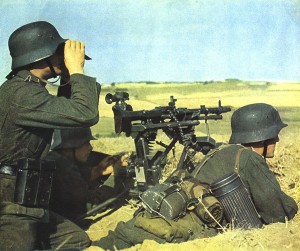 Each German soldier was issued a steel helmet with his uniform. As with almost everything to do with German equipment, there are multiple models and variants of the Stahlhelm. A good resource on this topic is www.german-helmets.com
Each German soldier was issued a steel helmet with his uniform. As with almost everything to do with German equipment, there are multiple models and variants of the Stahlhelm. A good resource on this topic is www.german-helmets.com
Essentially there are three models of wartime made combat helmet for infantry: the M35, which had a rolled edge rim and air riveted air vents, the M40 which was similar but had stamped embossed air vents and the M42, which had a “raw” unrolled edge rim. Additionally, a large number of First World War helmets were reconditioned and re-issued.
Whichever model helmet you go for, the essential thing is to buy a liner that fits your head, as liners for German helmets are non adjustable. There were six shell sizes that matched the liner size
Liner (cm) – Shell (cm)
52/53 cm – 60cm
54/55 cm – 62cm
67/57 cm – 64cm
58/59 cm – 66cm
60-61 cm – 68cm
62-63 cm – 70cm

Some vendors at the lower end of the price scale only stock the XXL 70cm shells and fit the wrong sized liner to the shell. Although there are wartime pictures of soldiers who have clearly been issued the wrong shell size, if you want a helmet that’s in proportion to your head, you need to make sure the shell size matches the liner size.
 The iconic boxhead design continued to be used after the war, mostly by German fire brigades, and occasionally a bargain comes up on eBay. These helmets have a cluster of seven punched air holes instead of a single air vent. Provided the liner chinstrap is a leather two point arrangement rather than a modern four point type, these can pass as a WW2 combat helmet if worn with a helmet cover.
The iconic boxhead design continued to be used after the war, mostly by German fire brigades, and occasionally a bargain comes up on eBay. These helmets have a cluster of seven punched air holes instead of a single air vent. Provided the liner chinstrap is a leather two point arrangement rather than a modern four point type, these can pass as a WW2 combat helmet if worn with a helmet cover.
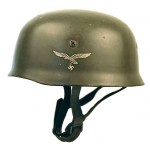 Paratroopers were issued with a pot shaped jump helmet which are today known as M38 helmets..
Paratroopers were issued with a pot shaped jump helmet which are today known as M38 helmets..
The Heer, the Waffen SS and the Luftwaffe all had Fallschirmjäger units, however not all paratroopers wore M38s. Once jump training was complete, the M38 was sometimes ordered returned and replaced with a standard infantry lid. This was more common as the war progressed and airborne units were simply used as infantry ground troops.
Paint
 Almost everything that was manufactured for the German military left the factory in a grey-green colour called Feldgrau. Typically, wartime Feldgrau is represented by RAL6006, however standardisation of paint shades seemed to be a big problem in the Third Reich and different factories issued new helmets in a variety of paint colours that varied from dark green to slate grey.
Almost everything that was manufactured for the German military left the factory in a grey-green colour called Feldgrau. Typically, wartime Feldgrau is represented by RAL6006, however standardisation of paint shades seemed to be a big problem in the Third Reich and different factories issued new helmets in a variety of paint colours that varied from dark green to slate grey.
Early war helmets were supposed to be finished in “apple green”, but even now there is no clear consensus on what this colour actually was. Once in the field, helmets could be repainted a number of times, either with a brush or spray-gun. The colours used would have been limited to what was available. In North Africa, huge stocks of British vehicle paint was captured and used to repaint helmets of DAK troops. In Italy, Italian paint was used. It is safe to say that no two German helmets were ever identical in colour.
 Camouflage helmet paint schemes were also not as common as some people like to believe, as it required access to the camouflage paint and spray equipment used on vehicles and artillery pieces.
Camouflage helmet paint schemes were also not as common as some people like to believe, as it required access to the camouflage paint and spray equipment used on vehicles and artillery pieces.
Decals
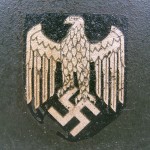 Even this seemingly trivial aspect of German helmets is the subject of volumes of observation and research. Decals are typically seen on early war helmets. Most original untouched wartime helmets have no decals, some have a single decal, a few have double decals. Eagles, SS runes, swastikas and national three colour shields were all officially approved, then ordered removed and painted over (or not) at some point in their history. Whether or not you have them depends very much on what period of the war you are aiming for.
Even this seemingly trivial aspect of German helmets is the subject of volumes of observation and research. Decals are typically seen on early war helmets. Most original untouched wartime helmets have no decals, some have a single decal, a few have double decals. Eagles, SS runes, swastikas and national three colour shields were all officially approved, then ordered removed and painted over (or not) at some point in their history. Whether or not you have them depends very much on what period of the war you are aiming for.
Helmet covers
 Helmet covers were introduced for SS units as early as 1937. A patent submitted in the name of Heinrich Himmler protected the design from being copied by the German Army, however in 1942 a general issue helmet cover for the Army in Splinter A pattern was factory produced and introduced to front line combat units, although not for every soldier. Field made helmet covers made from hessian and bed sheets were also common on the Eastern front
Helmet covers were introduced for SS units as early as 1937. A patent submitted in the name of Heinrich Himmler protected the design from being copied by the German Army, however in 1942 a general issue helmet cover for the Army in Splinter A pattern was factory produced and introduced to front line combat units, although not for every soldier. Field made helmet covers made from hessian and bed sheets were also common on the Eastern front
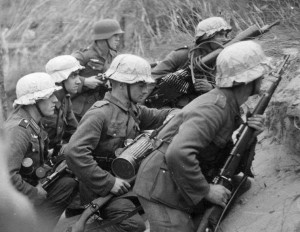
Wire
 Wire helmet covers were the German answer to the Allied string helmet net. Although the Germans didn’t use hessian scrim on their helmets, field made wire baskets that covered either the crown or the entire helmet and that could hold some form of foliage were sometimes added. In the absence of wire, a tyre inner tube would suffice. Wire on helmets was more prevalent in Normandy than in Russia as fencing wire was a scarce commodity on the steppes. When it came to using natural foliage as a way to break up the outline of a steel helmet the Germans preferred long grass and straw, so much so that US troops were forbidden from using grass in their helmet nets for fear that they would be mistaken for the enemy.
Wire helmet covers were the German answer to the Allied string helmet net. Although the Germans didn’t use hessian scrim on their helmets, field made wire baskets that covered either the crown or the entire helmet and that could hold some form of foliage were sometimes added. In the absence of wire, a tyre inner tube would suffice. Wire on helmets was more prevalent in Normandy than in Russia as fencing wire was a scarce commodity on the steppes. When it came to using natural foliage as a way to break up the outline of a steel helmet the Germans preferred long grass and straw, so much so that US troops were forbidden from using grass in their helmet nets for fear that they would be mistaken for the enemy.

Summary
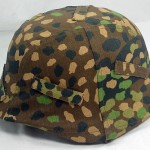 Getting the right helmet with the right accessories should involve more than just scanning a vendor’s website and picking stuff you like the look of. This should be the case for EVERYTHING you buy. Just because someone sells it, doesn’t mean it’s right. Apart from the availability on the repro market of fantasy items like Dot 44 and Sumpftarn helmet covers that were never actually issued to infantry troops, the accuracy of details like clip fastenings or drawstring, three panel or five panel construction and foliage loops should all be researched and confirmed before you part with your hard earned money. If you’re an impulse-buy, instant gratification type of person, then WW2 airsoft will end up being a VERY expensive hobby.
Getting the right helmet with the right accessories should involve more than just scanning a vendor’s website and picking stuff you like the look of. This should be the case for EVERYTHING you buy. Just because someone sells it, doesn’t mean it’s right. Apart from the availability on the repro market of fantasy items like Dot 44 and Sumpftarn helmet covers that were never actually issued to infantry troops, the accuracy of details like clip fastenings or drawstring, three panel or five panel construction and foliage loops should all be researched and confirmed before you part with your hard earned money. If you’re an impulse-buy, instant gratification type of person, then WW2 airsoft will end up being a VERY expensive hobby.
[divider]
